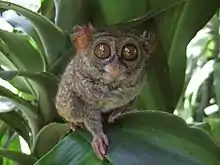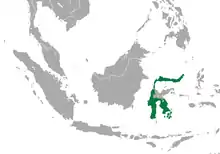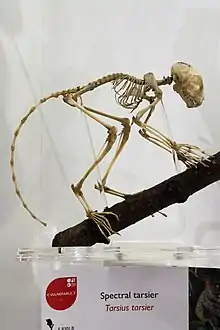Spectral tarsier
The spectral tarsier (Tarsius spectrum, also called Tarsius tarsier) is a species of tarsier found on the island of Selayar in Indonesia. It is apparently less specialized than the Philippine tarsier or Horsfield's tarsier; for example, it lacks adhesive toes. It is the type species for the genus Tarsius. While its range used to also include the population on nearby southwestern Sulawesi, this population has been reclassified as a separate species, Tarsius fuscus.[3] Some of the earlier research published on Tarsius spectrum refers to the taxon that was recently reclassified and elevated to a separate species, the Gursky's spectral tarsier (Tarsius spectrumgurskyae).[4]
| Spectral tarsier[1] | |
|---|---|
 | |
| Scientific classification | |
| Kingdom: | Animalia |
| Phylum: | Chordata |
| Class: | Mammalia |
| Order: | Primates |
| Suborder: | Haplorhini |
| Family: | Tarsiidae |
| Genus: | Tarsius |
| Species: | T. spectrum |
| Binomial name | |
| Tarsius spectrum (Erxleben, 1777) | |
 | |
| Spectral tarsier (Tarsius tarsier) range (including the recently split Tarsius fuscus) | |
Taxonomy and evolution
"Tarsiers were once thought to be of the Strepsirrhini suborder, grouped with Lemuroidea and Lorisidae because of their similar appearance and because they have a small stature and are also nocturnal. It has been decided that tarsiers are members of the suborder haplorrhine, which is a suborder of primates that hosts tarsiers and the simians (Archuleta, 2019)."[5] According to Gursky et al. 2003, based on phylogenic research, tarsiers are more closely related to humans and apes then lemurs and lorises. Some scholarly articles suggest dividing the genus into 3 and some references reflect this attempted revised taxonomy. "This taxonomic discrepancy is strongly supported by data collection of physiological attributes such as coat colors, tail lengths, and size as well as molecular data (Gursky et al. 2003)."[6] According to animaldiversity.org there are 3 living clades of the Tarsius species. The western tarsiers, the Philippine tarsiers, and the Sulawesi tarsiers.[5]
Conservation Status
Sharon Gursky suggested changing the conservation status of the spectral tarsier from indeterminate to vulnerable in 1998.[7] Today, the spectral tarsier is still listed as vulnerable on the IUCN Red List assessment. "Habitat loss and deforestation contributes to a decline in tarsier populations. Currently, tarsiers reside in many protected areas (Archuleta S. 2019)."
Physical Characteristics

The spectral tarsier has a body weight of 200 grams, with a body length of 240 mm, a head body length of 80 mm, and a tail length of 160 mm.[8] When considered to include Tarsius fuscus, females of the species weigh between 102 and 114 grams (3.6 and 4.0 oz) while males are 118 to 130 grams (4.2 to 4.6 oz). It has a head-body length of 9.5 to 14 centimetres (3.7 to 5.5 in) and its tail length ranges from 20 to 26 centimetres (7.9 to 10.2 in).[9]
Lifespan
The average lifespan in the wild is thought to be 10 years; however, in captivity the closely related Horsfield's tarsier can live up to 17 years and it is thought the spectral tarsier may have similar longevity.[9] It is believed that old age begins affecting tarsiers behavior at between 14 and 16 years of age, and apparently, like us, their hair begins to turn gray.[5]
Distribution and habitat
Tarsiers inhabit the tropical forests and islands of Southeast Asia, but, according to the research done by Sabrina Archuleta with the University of Michigan's Museum of Zoology, eocene and Miocene tariser fossils have been found in China, Thailand, and southern Pakistan. The islands of Southeast Asia are actually an archipelago, which is a cluster or collection of islands. The tarsiers are found in forests that range in density and agriculture from island to island, including both primary and secondary habitats. "They roost in dense vegetation, shrubs, bamboo, palm, dense thickets of grass, bush, thorn scrubs, and secondary habitats on plantations for logging and growing coffee, nutmeg, coconut, or coca crops (Archuleta, S. 2019)."[5]
Food and foraging
In a study done by John and Kathy MacKinnon, it was found that tarsiers consume a completely carnivorous diet. Although some species will prey on small birds and rodents, their diet consists mainly of insects that they collect from the ground, air, and on tree branches and leaves (Mackinnon et al., 1980).[10]
Behavior
Tarsiers are nocturnal mammals. They wake up at sunset and spend the nights foraging for insects and eating. They travel between trees and socialize, which usually includes grooming one another, scent marking, playing and vocalizing (Gursky et al. 2000).[11]
Social structure
At the very base of the tarsier society is that they live in groups and men and women have different roles. Males tend to travel longer distances and they occupy a larger area. Females tend to hunt more efficiently and they also consume more insects. A study done by Sharon Gursky in 1998 defines group size as the number of individuals sharing a sleeping site. She goes on to say that these groups are usually composed of 2 to 6 individuals. The study was done in the Tangkoko Dua Saudara Nature Reserve and Gursky et al. found that 14% of groups contained more than 1 adult female. "In one of the groups with two adult females, both females gave birth to infants (Gursky et al. 1998)."[7] In the research done by Sabrina Archuleta, it was found that tarsiers can be both monogamous and polygynous. She found that some live in pairs or groups and some males may even live alone.[5]
Reproduction and parenting
.jpg.webp)
.jpg.webp)
In a study done in North Sulawesi, Indonesia in 2007, the Mackinnons found that the spectral tarsiers were monogamous and territorial. They found that families slept at the same sites each day and that they gave loud duet songs as they gathered at sleeping sites. As their study went on they found that tarsier young are quite advanced and that they start traveling alone at as young as 23 days (Mackinnon et al. 1980).[10] Hidayatik et al. did a 9 month survey in 2018 where they found that the tarsiers courtship behaviours consist of scent marking and genital marking for females and that males use genital inspection. They recorded that copulations lasted between 3 and 4 minutes and occurred only once per pair for the duration of the study (Hidayatik et al. 2018).[12]
Sharon Gursky did a study in the a northern Sulawesi rain forest in 1994 where she found that infants were alone from 40%-50% of the time. Gursky et al. found that the two subadults in the group were more regularly caring for the infant than the adult males, females or mothers were. They believe that these results suggest that subadults are actually guarding or babysitting the infants (Gursky et al. 1994).[13] Infanticide has been reported by Gursky, but only in one case and by a neighboring adult male. "The only hypothesis that could not be rejected outright, on the basis of this single observation, was the competition for limited resources hypothesis (Gursky et al. 2011)."[14]
Competition
According to the study done by the Mackinnons, tarsiers scent mark their ranges by rubbing branches with urine and special epigastric glands (Mackinnon et al. 1980).[10] It was found that the primary predators of the tarsiers are monitor lizards, civets, snakes, and diverse birds of prey. "Tarsier niches are largely as predator and prey. Their presence affects the population size of organisms that they feed on and of those who feed on them (Archuleta S. 2019)." Archuleta goes on to say that they are host to many endo- and ectoparasites, including mites and intestinal worms.[5]
Communication
A study done in 2019 by Sharon Gursky found that spectral tarsiers use ultrasonic vocalizations. These are high frequency and can only travel short distances. Gursky identifies this as echolocation and says it is used for navigation (Gursky et al. 2019).[15] "There are 5 main categories of vocalizations: chirps, twitters, choruses, doubles and whistles. Chirps, twitters, and choruses extended from the audible to the ultrasonic range, the doubles and whistles were pure ultrasound (Gursky et al. 2015)."[16]
Archuleta S. 2019 talks about how vocalizations include high pitched whistles and duets. She goes on to say that duets are like chattering melodies and high pitched whistles vary from simple calls to predator warnings; to mob, or ward off a predator.[5] "In the presence of bird predators, individuals vocalize and disperse to hide. When in the presence of a terrestrial predator, such as a snake, individuals "mob" the threat (Archuleta S. 2019)." Sharon Gursky describes mobbing as all the individuals in an area responding to a threat with vocalizations and then each repeats lunging towards and retreating from the predator (Gursky et al. 2006).[17]
References
- Groves, C. P. (2005). "Order Primates". In Wilson, D. E.; Reeder, D. M (eds.). Mammal Species of the World: A Taxonomic and Geographic Reference (3rd ed.). Johns Hopkins University Press. p. 128. ISBN 978-0-8018-8221-0. OCLC 62265494.
- Shekelle, M. & Salim, A. (2008). "Tarsius tarsier". IUCN Red List of Threatened Species. 2008: e.T21491A9288932. doi:10.2305/IUCN.UK.2008.RLTS.T21491A9288932.en.
- Groves, C.; Shekelle, M. (2010). "The genera and species of Tarsiidae". International Journal of Primatology. 31 (6): 1071–1082. doi:10.1007/s10764-010-9443-1. S2CID 21220811.
- Shekelle, Myron; Groves, Colin P.; Maryanto, Ibnu; Mittermeier, Russell A. (2017). "Two new tarsier species (Tarsiidae, Primates) and the biogeography of Sulawesi, Indonesia" (PDF). Primate Conservation. 31.
- Archuleta, Sabrina. "Tarsius (tarsiers)". Animal Diversity Web.
- Gursky, Sharon (6 January 2003). "The behavioral ecology of the spectral tarsier, Tarsius spectrum". Evolutionary Anthropology: Issues, News, and Reviews. 11 (6): 226–234. doi:10.1002/evan.10035. S2CID 85603691.
- Gursky, Sharon (1998). "Conservation Status of the Spectral Tarsier Tarsier spectrum: Population Density and Home Range Size". Folia Primatologica. 69 (1): 191–203. doi:10.1159/000052713. S2CID 84689583.
- "Spectral Tarsier". Encyclopedia of Life. National Museum of Natural History, Smithsonion. Retrieved 27 February 2020.
- Mogk, K. (2012). "Tarsius tarsier". Animal Diversity Web.
- MacKinnon, John; MacKinnon, Kathy (December 1980). "The behavior of wild spectral tarsiers". International Journal of Primatology. 1 (4): 361–379. doi:10.1007/BF02692280. S2CID 20758661.
- Gursky, Sharon (May 2000). "Sociality in the spectral tarsier,Tarsius spectrum". American Journal of Primatology. 51 (1): 89–101. doi:10.1002/(SICI)1098-2345(200005)51:1<89::AID-AJP7>3.0.CO;2-7. PMID 10811442.
- Hidayatik, Nanik; Yusuf, Tuty Laswardi; Agil, Muhammad; Iskandar, Entang; Sajuthi, Dondin (2018). "Sexual Behaviour of the Spectral Tarsier (Tarsius spectrum) in Captivity". Folia Primatologica. 89 (2): 157–164. doi:10.1159/000486412. PMID 29597228. S2CID 4491170.
- Gursky, Sharon L. (1 December 1994). "Infant care in the spectral tarsier (Tarsius spectrum) Sulawesi, Indonesia". International Journal of Primatology. 15 (6): 843–853. doi:10.1007/BF02736071. ISSN 1573-8604. S2CID 9327191.
- Gursky-Doyen, Sharon (19 August 2011). "Infanticide by a male spectral tarsier (Tarsius spectrum)". Primates. 52 (4): 385–389. doi:10.1007/s10329-011-0264-4. PMID 21853266. S2CID 9370511.
- Gursky, Sharon (2019). "Echolocation in a Nocturnal Primate?". Folia Primatologica. 90 (Suppl. 5): 379–391. doi:10.1159/000497811. PMID 31416091. S2CID 146037219.
- Gursky, Sharon (28 April 2015). "Ultrasonic Vocalizations by the Spectral Tarsier, Tarsius spectrum". Folia Primatologica. 86 (3): 153–163. doi:10.1159/000371885. PMID 25925962.
- Gursky, Sharon (March 2002). "Determinants of gregariousness in the spectral tarsier (Prosimian: Tarsius spectrum)". Journal of Zoology. 256 (3): 401–410. doi:10.1017/S0952836902000444.

